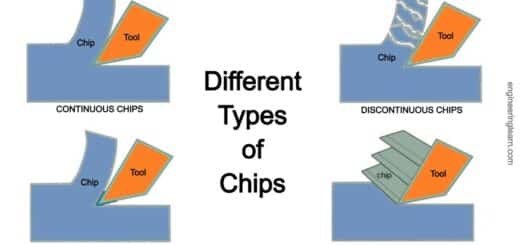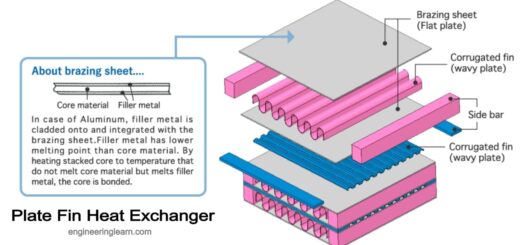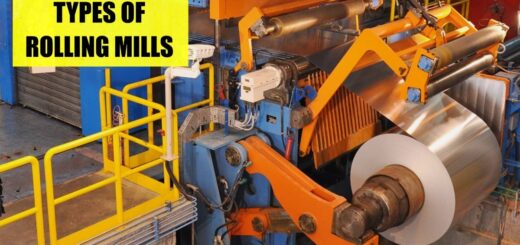6 Types of Aluminum – Uses and Grades [Explained with Complete Details]
![6 Types of Aluminum - Uses and Grades [Explained with Complete Details]](https://engineeringlearn.com/wp-content/uploads/2022/12/Aluminum-1024x539.jpg)
6 Types of Aluminum: – Numerous types of aluminum alloys can be used for various goods and tasks. Although it would be difficult to cover every type of aluminum, the most popular types and their uses are listed below.
Types of Aluminum
1. Hardest Aluminum: 2024-T351: ( Types of Aluminum )
Aluminum with a characterization of 2024-T351 is the hardest, yet it’s difficult to work with. This sort of hardness is normal in planes and riveting ventures, yet you can’t weld it.
Example: – Stacked aluminum sheets
2. Aluminum that is most Flexible: ( Types of Aluminum )
Because the aluminum is flattened into thin sheets throughout its manufacturing process, aluminum alloy foil is the most flexible variety of aluminum. Foil is used by consumers to wrap food, and many businesses use it to package goods like consumables, cosmetics, and home goods.
Example: – Alloy aluminum foil
3. Sheet Aluminum: ( Types of Aluminum )
Sheet aluminum is framed by stepping or turning, and it expects combination to make major areas of strength for it. Pots and skillet might contain alloyed aluminum, for instance, with normal composites like magnesium, copper, and bronze joining with the material for strength and toughness.
Example: – The method involved with assembling aluminum sheet.
4. Aluminum Clad: ( Types of Aluminum )
Aluminum that has been coated with zinc, silicon, copper, stainless steel, nickel, or magnesium is known as treated aluminium or clad aluminium. Because bare aluminium is so easily corroded, cladding increases corrosion resistance.
Due to its durability, clad aluminum is a staple material in the aerospace and food processing industries.
5. Exposed Aluminum: ( Types of Aluminum )
Exposed aluminum consumes, and as it oxidizes, it loses its intelligent properties. Be that as it may, the consumption seals out dampness and air, so the inside material is as areas of strength for yet. On the off chance that you have a venture where looks don’t make any difference, allowing the metal to consume on its surface may be a decent strategy.
6. Alloys used in Aluminum Manufacturing: ( Types of Aluminum )
- Ball bearing cages for die sets made of aluminium alloy
- Aluminum alloys are another sort of common aluminium used in production. Each class begins with a number between one and seven and is a series. Each series employs a unique alloy in the process of manufacturing it, and even within a series, there can be many differences in usage and traits.
- 1000 series is the most perfect at almost 100% least aluminum. It’s utilized in substance tanks and conductive transport bars.
- 2000 series aluminum has copper amalgam and is normal in airplane and aviation applications.
- Manganese alloy, which is popular in cookware and automobiles, is found in the 3000 class.
- Using silicon in the 4000 series lowers the melting point of the alloy. A lot of welders use this alloy.
- 5000 series have magnesium and silicone and make up underlying pieces like bars, cylinders, and points.
- 7000 series have zinc amalgams and deal high strength in aviation and donning ventures.
- Working with high-strength aluminium alloys can be difficult and expensive, but new research is making things easier.
- The Pacific Northwest National Laboratory utilizes a combination powder to make consistent aluminum parts, eliminating expensive and energy-consuming advances. The aluminum coming about because of this cycle is more pliable, as well, making them impervious to breakage.
What Home Products Use Aluminium?
You might be shocked to learn how strongly aluminium is used in many everyday items, construction supplies, and even homes themselves. Here is more information about the various household products that use aluminium.
1. Aluminum Siding
Closeup of aluminum siding on a structure.
Siding comes from aluminum loop stock. The loop stock gets a substance coat, then goes through a financial cycle. Various surfaces are accessible (accomplished by adding polish), as well.
In examinations of aluminium siding, specialists look at things like grounding (the metal can conduct electricity) and magnetism to determine whether the metal is made of aluminium or steel (magnets will stick to steel). Additionally, your siding shouldn’t touch the ground since this could attract bugs that eat wood from your home’s structure.
Aluminum siding is solid and handles paint application well. The issue is on the grounds that you apply it in sheets, it very well may be trying to fix. It’s likewise energy-concentrated to make, so it’s not as well known in that frame of mind as it was pre-1970.
2. Aluminum Furniture
Aluminum Patio Furniture
You can track down furniture in expelled aluminum, cast aluminum, and fashioned aluminum types. Expelled aluminum is lightweight however less strong, while cast aluminum has a powder coat to shield it from oxidation and other harm. To project aluminum furniture, metalworkers liquefy it and empty it into molds.
Fashioned aluminum, then again, requires working while cold. Metalworkers use devices to bend the metal the manner in which they need it. Numerous mortgage holders favor aluminum since it weighs not exactly other metal furnishings and can endure brutal atmospheric conditions without separating (regardless of whether it become scratched).
3. Aluminum Foil
Family foil isn’t unadulterated aluminum. All things considered, it’s a combination with somewhere in the range of 92 and 99 percent aluminum. Its thickness is slight — a limit of 0.0059 inches — and it comes in numerous varieties. Many individuals erroneously call it tin foil in light of the fact that, in the late nineteenth 100 years, foil came from a tin.
Today, however, producers use aluminum — which is less expensive than tin — to make foodservice and different kinds of bundling from this pliable metal.
4. Cans of Aluminium
Beverage cans made of aluminium
Cans are yet another commonplace object made of aluminium. Aluminum cans are a common packaging material for foods and beverages like soup, soda, and beer. Aluminum cans can also contain household goods like oil and chemicals, and the majority of them can be recycled after use.
5. Aluminum Roofs
Aluminium is a great material choice if you can get past the annoying sound of rain or other objects falling on your roof. You can live dry and comfortably for years thanks to its durability and waterproof qualities. Although it will show signs of thunderstorms (and hail), the lightweight metal is simpler to install and maintain than steel roofing.
6. Exterior Structures
Did you know that aluminium ranks second in terms of usage in construction? Only steel is more widely used (but much heavier). Although some residences also use aluminium alloys in their construction, sheds, shops, and even garages can benefit from aluminium.
Buildings made of aluminium are frequently less expensive than those made of wood and are also resistant to fire and other abrasive elements. However, they are susceptible to overheating and condensation.
7. Aluminum Insulation
Many sorts of protection use aluminum for keeping heat in. All alone, however, sheets of aluminum don’t do much for keeping up with warmth. Joined with different kinds of protection materials, similar to cotton, aluminum makes a fair boundary against energy misfortune.
8. Aluminum Pots and Pans
Aluminum pots sitting on an enlistment center point.
Consuming an excessive amount of aluminum isn’t good for anybody. Yet, specialists affirm that utilizing aluminum cookware is protected and that the aluminum for the most part won’t filter into food. Nonetheless, you shouldn’t prepare acidic food in your aluminum cooking pots — it can influence the flavor of the food and harm your skillet.
The comparatively soft aluminium is formed into the proper size and shape by manufacturers, who recycle the shavings they produce. When pure aluminium is the proper shape, producers cut holes so that handles and fittings may be attached.
Some aluminium pans are made entirely of aluminium, with no coatings or alloys. However, other pots and pans have non-reactive coatings like stainless steel or other materials so you may cook almost anything in them.
9. Aluminum Home Furnishings
You may get aluminium house decor for any decorating plan, regardless of your sense of style. Lighting fixtures, candlesticks, wall artwork, wind chimes, and a tonne of other aluminium home decor items are all readily available.
10. Aluminum Wires
However aluminum wiring isn’t great for home development purposes, some time ago the United States involved it for wiring houses. Aluminum wiring was normal from the ’60s to the ’70s, when copper became expensive.
A great many people choose to trade out old aluminum wiring in view of fire gambles. The wiring all alone is fine, yet when it interfaces with light switches and outlets (or different wires), there’s a gamble of crumbling. Aluminum gets hot and grows, which is likewise a no for electrical parts.
You can figure out whether you have aluminum wiring by actually looking at the electrical board. The links frequently read “AL” or “ALUM” or even illuminate aluminum. Trading for copper wires implies lower fire dangers and better dependability.
Different Grades of Aluminum
The various grades of aluminium that are available are the first thing you need to be aware of. There are three fundamental varieties of aluminium: 1100, 3003, and 6061. The pricing point and end use application will depend on the aluminium grade. For instance, 1100 costs less than 6061 but can’t be utilised for high-temperature applications like pot lids or cooking utensils.
A) 3003 Aluminum
3003 aluminum is unadulterated aluminum with an expansion of manganese to expand its solidarity. As a compound of aluminum, it has, ostensibly, 1.2% Mn, 0.12% Cu, and 98.6% Al. It is promptly weldable, has a generally minimal expense for every pound, and can be utilized in many applications. It doesn’t have the consumption opposition of 6061 or 1100, however it is an efficient option in contrast to those grades for certain reasons.
The most popular type of aluminium is 3003 aluminium. Although it is a general-purpose alloy, it cannot withstand high temperatures like those found in an oven or grill. As a result, it cannot be used for cooking utensils or pot lids.
B) 6061 Aluminum
Aluminum grade 6061 is frequently called “The Workhorse Aluminum.” It has much preferred erosion opposition over 300 series composites. Different advantages incorporate its high intensity welding properties as well as its solidarity when contrasted and a similar thickness of 250 compounds.
Products that see a lot of wear and tear, like guttering or furniture with exposed edges, can be made from this aluminium alloy. Because of its greater strength and superior corrosion resistance compared to other grades, it is the ideal choice to use in environments with high amounts of humidity.
C) 1100 Aluminum
This is the most perfect type of aluminum industrially accessible, as it’s made with close to 100% min virtue. It has amazing usefulness and pliability. This settles on it an extraordinary decision for testing framing tasks. Despite the fact that this metal doesn’t solidify when worked or warmed as different metals do, its erosion opposition and weldability make it exceptionally flexible. Its high warm conductivity likewise gives it an edge in applications that require warm conductivity.
Because aluminium 1100 is a flexible metal, it may be formed into a variety of goods. Chemical machinery, fin stock, dials, railroad tank waggons, and nameplates used in the manufacturing sector are a few examples. This flexible yet sturdy alloy is also utilised by producers of cooking utensils and fasteners for building projects, as well as by businesses in the plumbing and lighting industries.
Aluminum is perhaps of the most adaptable metal on the planet. It has a large number of utilizations and is a significant structure material that can be utilized in a wide range of ways, from development to cooking tools. Notwithstanding, you really want to find the right provider whether you want 3003 aluminum or some other grade.
Aluminum’s Characteristics
Did you know that the Empire State Building, built in 1930, was the first major structure to use aluminium? It is sturdy, weatherproof, and dependable in a variety of applications.
1) Ecological Resistance
Aluminum has outstanding protection from the climate and other harming components. It can curve and imprint, particularly when untreated, however it won’t break or dissolve. Furthermore, with additional coatings, paint, and different medicines, you can make it look some way you need.
2) Resistance
Although aluminium can sustain numerous dings and scratches, it still maintains its overall strength. It will continue to function as predicted even if you sit on it, bend it, or leave it in the sun.
3) Lightweight
However steel is a standard metal for the overwhelming majority development projects, it’s bulky. Steel is 2.5 times denser than aluminum, as a matter of fact. Per cubic foot, steel loads 489 pounds while aluminum weighs 168.5 pounds. While planning a structure, that weight can have a huge effect in the task’s result — and cost.













